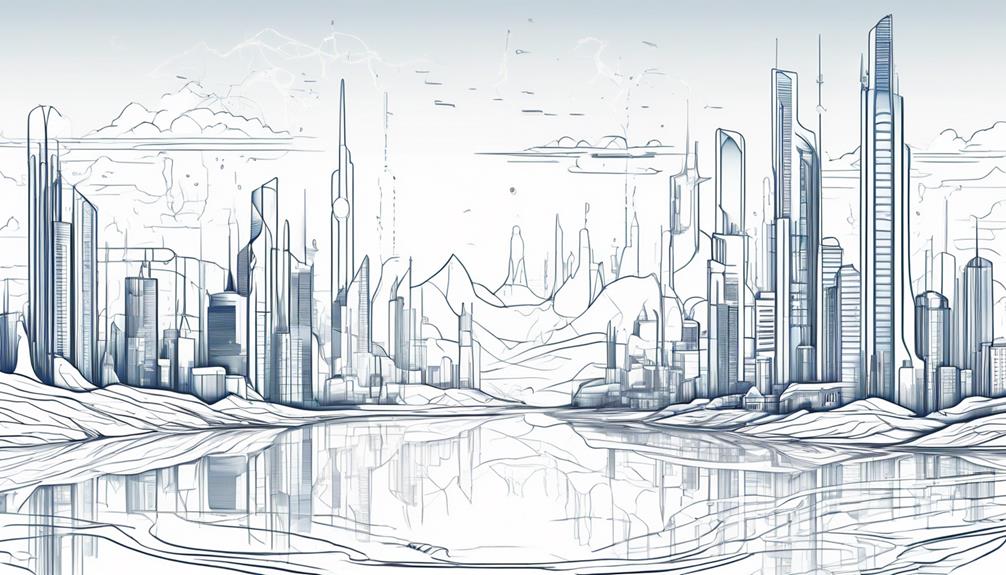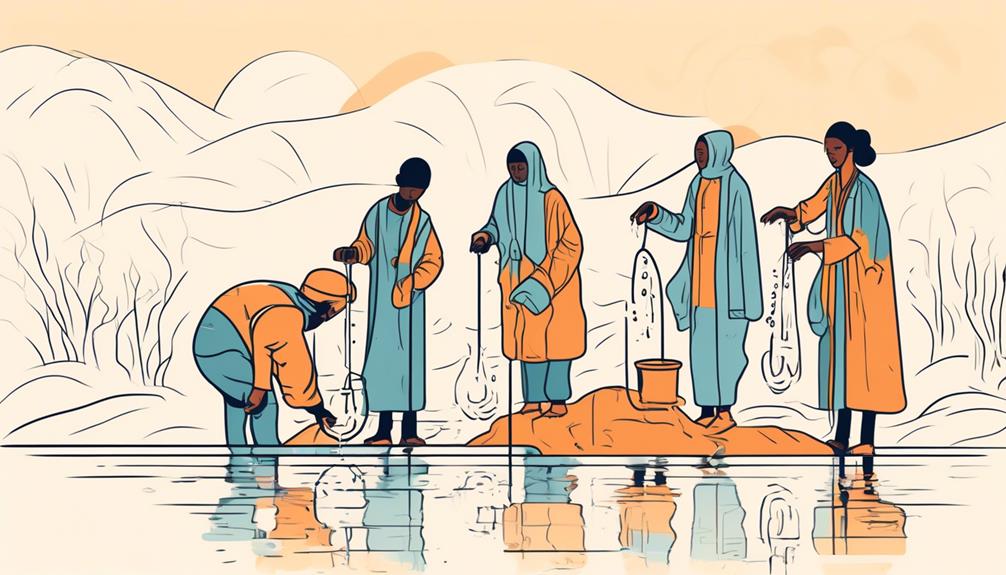Ever wondered why water scarcity seems to have society in a tight grip, refusing to let go? Well, the answer lies in the intricate web of interconnected factors that shape our world.
From the way we structure our economies to the very fabric of our social interactions, the impact of water scarcity runs deep.
So, let's take a closer look at the ripple effects of this fundamental resource shortage and how it weaves its way into every aspect of our lives.
Key Takeaways
- Water scarcity has profound economic impacts, including increased production costs, reduced agricultural output, challenges for water-reliant industries, hindering economic growth, and leading to job losses.
- The health consequences of water scarcity are significant, with increased risks of waterborne diseases, malnutrition, dehydration, mental health strains, and an overall impact on well-being, emphasizing the importance of addressing water scarcity for health.
- Social inequality and economic disparities are exacerbated by water scarcity, leading to limited access to clean water, impacting marginalized communities, and highlighting the need for addressing social injustice, income disparities, rising unemployment rates, and increased healthcare costs.
- Challenges in access to resources due to water scarcity include health impacts, reduced education opportunities, limits on economic development, strains on community relationships, and disproportionate effects on marginalized communities.
Economic Impacts of Water Scarcity
Water scarcity significantly impacts the economy by increasing production costs and reducing agricultural output. When water is scarce, industries that rely heavily on water, such as agriculture, manufacturing, and energy production, face challenges. For example, farmers may struggle to irrigate their crops, leading to lower yields and higher food prices for consumers. Additionally, manufacturing plants may incur higher expenses to source water for their production processes, ultimately passing these costs onto consumers.
Moreover, water scarcity can hinder economic growth by limiting the expansion of businesses that require water for their operations. Industries like tourism, which rely on water for recreational activities and hospitality services, may suffer due to dwindling water resources. This can result in job losses and reduced income for communities that depend on these industries for their livelihoods.
In essence, the economic impacts of water scarcity are far-reaching, affecting various sectors and ultimately burdening consumers with higher prices and reduced economic opportunities.
Health Consequences of Water Scarcity
Struggling to access an adequate water supply can have severe health implications for individuals and communities alike. The health consequences of water scarcity are far-reaching and can significantly impact overall well-being. Here are three crucial ways in which water scarcity affects health:
- Increased Risk of Waterborne Diseases: Limited access to clean water for drinking, cooking, and personal hygiene can lead to a higher prevalence of waterborne diseases such as cholera, typhoid fever, and diarrhea.
- Malnutrition and Dehydration: Water scarcity can hinder agricultural productivity, leading to food shortages and malnutrition. Additionally, inadequate water intake due to scarcity can result in dehydration, impacting bodily functions and overall health.
- Mental Health Strain: Dealing with the daily stress and uncertainty of not having enough water can take a toll on mental well-being. Anxiety, depression, and other mental health issues can arise from the constant struggle for water access.
Addressing water scarcity is crucial not only for ensuring basic health needs are met but also for promoting thriving communities.
Social Inequality and Water Scarcity
When it comes to social inequality and water scarcity, economic disparities worsen, leading to limited access to essential resources like clean water.
This means that those already facing financial challenges are disproportionately affected by the scarcity of water, exacerbating existing inequalities.
Addressing these issues is crucial to ensure that everyone has equal opportunities to access this vital resource.
Economic Disparities Worsen
Exacerbating existing social inequalities, the scarcity of water is deepening economic disparities within society. This widening gap is evident in various ways:
- Income Disparities: Limited access to clean water disproportionately affects low-income communities, who often end up paying more for water than those in wealthier areas.
- Unemployment Rates: Industries reliant on water, such as agriculture, face challenges leading to job losses, impacting the livelihoods of many.
- Healthcare Costs: Waterborne illnesses strain healthcare systems, with marginalized groups bearing the brunt of medical expenses.
These economic disparities not only hinder individual prosperity but also perpetuate societal inequality, highlighting the urgent need for sustainable water management practices.
Access to Resources Limited
Limited access to essential resources, such as clean water, intensifies social inequalities, impacting various facets of community well-being. This disparity in access to water resources disproportionately affects marginalized communities, exacerbating existing social injustices. Lack of clean water leads to health issues, hindering educational opportunities and economic growth in these communities. Here is a breakdown of how limited access to resources affects society:
| Aspect | Impact |
|---|---|
| Health | Increased risk of waterborne diseases |
| Education | Reduced school attendance and performance |
| Economic Development | Limited job opportunities and productivity |
| Social Cohesion | Strains community relationships |
Political Ramifications of Water Scarcity
With water scarcity becoming a pressing issue globally, the political landscape is significantly impacted as governments strive to manage this critical resource. The political ramifications of water scarcity are far-reaching and can have profound effects on the stability and development of societies.
Here are three key ways in which water scarcity influences politics:
- Conflict Potential: Competition over limited water resources can lead to tensions between regions or even countries, potentially sparking conflicts and exacerbating existing geopolitical disputes.
- Policy Decisions: Governments are forced to make tough decisions regarding water allocation, infrastructure development, and conservation measures, which can have wide-ranging implications for their populations and economies.
- International Relations: Water scarcity can strain diplomatic relations as countries seek to secure access to water sources through treaties, negotiations, or other means, highlighting the interconnectedness of global water issues and the need for cooperation.
Technological Solutions for Water Scarcity

Let's talk about how innovative filtration systems, desalination methods, and smart irrigation technologies can play a crucial role in addressing water scarcity.
These solutions aim to provide clean water through advanced filtration processes, convert seawater into drinkable water, and optimize water usage in agriculture to conserve this vital resource.
Embracing these technological advancements can significantly impact how we tackle water scarcity challenges in our communities.
Innovative Filtration Systems
Innovative filtration systems offer a promising solution to address the challenges posed by water scarcity in society. These advanced technologies play a crucial role in ensuring access to clean water for all.
Here are three key benefits of innovative filtration systems:
- Efficiency: Modern filtration systems can efficiently remove contaminants, providing safe drinking water even in regions facing water scarcity.
- Sustainability: By using innovative filtration methods, water can be purified and reused, promoting sustainable water management practices.
- Cost-effectiveness: These systems offer a cost-effective way to treat water, making clean water more accessible to communities that struggle with scarcity.
Embracing these filtration technologies can significantly improve water availability and quality in areas affected by water scarcity.
Desalination for Clean Water
Desalination technology offers a viable solution to combat water scarcity by providing clean water through the removal of salt and impurities from seawater. This process holds immense potential to alleviate water stress in regions facing shortages. Consider the impact of this technology visually through the table below:
| Benefits of Desalination | Emotional Response |
|---|---|
| Provides clean drinking water | Relief and gratitude |
| Reduces dependence on limited freshwater sources | Hope for the future |
| Mitigates health risks related to contaminated water | Peace of mind |
| Supports agricultural and industrial needs | Sense of security |
Through desalination, communities can secure a sustainable water source, fostering a sense of security and well-being.
Smart Irrigation Technologies
Moving from the solution of desalination for clean water, smart irrigation technologies present another effective approach to addressing water scarcity by optimizing water usage in agricultural practices. By implementing these technologies, you can significantly reduce water wastage and improve crop yields.
Here's how smart irrigation systems can benefit you:
- Precision Watering: Smart systems use sensors to determine the exact water needs of plants, ensuring they receive just the right amount of water.
- Remote Monitoring: You can monitor and control irrigation systems from your phone or computer, making adjustments in real-time based on weather conditions or soil moisture levels.
- Water Conservation: These technologies help in conserving water resources by preventing overwatering and runoff, promoting sustainable agricultural practices.
Cultural Perspectives on Water Scarcity

Water scarcity holds diverse implications for different cultures around the world. In some cultures, water is revered as a sacred element, essential for spiritual rituals and purification ceremonies. For example, in certain Indigenous communities, water is seen as a living entity, connecting past, present, and future generations. The scarcity of water disrupts these cultural practices and erodes the spiritual connection to the land and ancestors.
Conversely, in urban societies, water scarcity can lead to social unrest and political tensions. Access to clean water is crucial for public health and economic stability. When water sources diminish, competition for this vital resource intensifies, leading to conflicts within and between communities. Additionally, in many cultures, water plays a central role in traditional cuisines and agricultural practices. The lack of water can threaten food security and disrupt longstanding culinary traditions.
Understanding these diverse cultural perspectives on water scarcity is vital for developing effective strategies to address this global challenge. By recognizing the cultural significance of water, societies can work towards sustainable solutions that respect and integrate diverse beliefs and practices.
Frequently Asked Questions
How Does Water Scarcity Affect Wildlife and Ecosystems?
Water scarcity affects wildlife and ecosystems by disrupting habitats, reducing food sources, and causing species to migrate or face extinction. You must consider these impacts when addressing water scarcity's broader societal consequences.
What Role Does Climate Change Play in Exacerbating Water Scarcity?
Feeling the heat, climate change intensifies water scarcity. Rising temperatures alter rainfall patterns, leading to droughts. This disrupts water availability, affecting agriculture, health, and economies worldwide. Adapting to these changes is crucial for sustainability.
Are There Any Psychological Impacts of Living in a Water-Scarce Environment?
Living in a water-scarce environment can lead to stress, anxiety, and even depression due to constant worry about finding clean water. This can affect your mental well-being, relationships, and overall quality of life.
How Do Different Regions Around the World Prioritize Water Allocation During Times of Scarcity?
In different regions, priorities shift during water scarcity. Some focus on agriculture for food security, while others prioritize drinking water for basic needs. Decisions vary but reflect the struggle to balance essential uses.
What Long-Term Effects Does Water Scarcity Have on Agricultural Practices and Food Security?
When water is scarce, agricultural practices suffer, leading to reduced crop yields, food shortages, and economic instability. You must adapt by implementing efficient irrigation methods, crop diversification, and water conservation strategies for long-term sustainability.
Conclusion
You may not realize it, but water scarcity's grip on society is tight. It squeezes economies dry, leaving health in a drought. Social divides widen, politics muddy the waters.
Yet, technology offers a glimmer of hope. Cultures clash over this precious resource. In a world thirsty for change, the impact of water scarcity runs deep, shaping our world in ways we can't ignore.